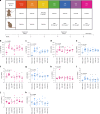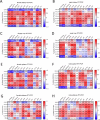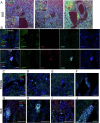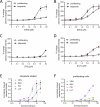IL-23R is a senescence-linked circulating and tissue biomarker of aging
- PMID: 39658621
- PMCID: PMC11839461
- DOI: 10.1038/s43587-024-00752-7
IL-23R is a senescence-linked circulating and tissue biomarker of aging
Abstract
Cellular senescence is an aging mechanism characterized by cell cycle arrest and a senescence-associated secretory phenotype (SASP). Preclinical studies demonstrate that senolytic drugs, which target survival pathways in senescent cells, can counteract age-associated conditions that span several organs. The comparative efficacy of distinct senolytic drugs for modifying aging and senescence biomarkers in vivo has not been demonstrated. Here, we established aging- and senescence-related plasma proteins and tissue transcripts that changed in old versus young female and male mice. We investigated responsivity to acute treatment with venetoclax, navitoclax, fisetin or luteolin versus transgenic senescent cell clearance in aged p16-InkAttac mice. We discovered that age-dependent changes in plasma proteins, including IL-23R, CCL5 and CA13, were reversed by senotherapeutics, which corresponded to expression differences in tissues, particularly in the kidney. In plasma from humans across the lifespan, IL-23R increased with age. Our results reveal circulating factors as candidate mediators of senescence-associated interorgan signal transduction and translationally impactful biomarkers of systemic senescent cell burden.
© 2024. The Author(s).
Conflict of interest statement
Competing interests: M.J.S., C.M.C., A.J.H., E.J.A., N.K.L. and Mayo Clinic have intellectual property related to this research. This research was reviewed by the Mayo Clinic Conflict of Interest Review Board and was conducted in compliance with Mayo Clinic Conflict of Interest policies. D.J.B. has a potential financial interest related to this research. He is a co-inventor on patents held by Mayo Clinic, patent applications licensed to or filed by Unity Biotechnology, and a Unity Biotechnology shareholder. Research in the Baker laboratory has been reviewed by the Mayo Clinic Conflict of Interest Review Board and is being conducted in compliance with Mayo Clinic Conflict of Interest policies. The other authors declare no competing interests.
Figures














References
-
- Bianchi, T., Rufer, N., MacDonald, H. R. & Migliaccio, M. The tumor suppressor p16Ink4a regulates T lymphocyte survival. Oncogene25, 4110–4115 (2006). - PubMed
MeSH terms
Substances
Grants and funding
- R01 AG071686/AG/NIA NIH HHS/United States
- R01 HL167796/HL/NHLBI NIH HHS/United States
- UG3 CA275669/CA/NCI NIH HHS/United States
- S10 OD030332/OD/NIH HHS/United States
- R00 AG058798/AG/NIA NIH HHS/United States
- 1 S10OD030332-01/Foundation for the National Institutes of Health (Foundation for the National Institutes of Health, Inc.)
- K99/R00 AG058798/Foundation for the National Institutes of Health (Foundation for the National Institutes of Health, Inc.)
- K99 AG058798/AG/NIA NIH HHS/United States
- P01 AG062413/AG/NIA NIH HHS/United States
LinkOut - more resources
Full Text Sources
Medical

